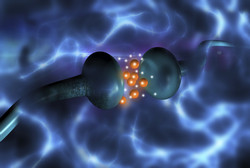Fluorescence imaging for drug discovery
Dopamine receptors regulate a number of functions such as memory, attention and food intake. The dopaminergic system is also implicated in various neurological conditions such as schizophrenia and Parkinson’s disease. Understanding the molecular mechanisms behind dopamine receptor interaction is of outmost importance. The EU-funded GPCR-LGIC COUPLING (Interactions between G-protein Coupled Receptors and Ligand Gated Ion Channels) project set out to elucidate the physical interaction of three of the most important dopamine receptors namely adenosine A2A, dopamine D2 and N-methyl D-aspartate (NMDA) receptors. Upon binding of the neurotransmitter dopamine, receptors form homodimers or heterodimers and activate G proteins, which in turn transmit the signal within the cell. To image such processes, scientists used fluorescence resonance energy transfer (FRET). They labelled these receptors with a green or red fluorophore in live cells and then used a laser scanning confocal microscope to observe their interaction. The consortium obtained detailed images of dopamine receptor location and co-localisation with other receptors. They discovered that NMDA receptors interact with A2A or D2R receptors alone but not with the A2A-D2R heterodimer. The fluorescence-based live cell model was also used to screen the impact of antipsychotic drugs. A number of A2AR and D2R agonists were thus tested for their effect on receptor dimerisation. Administration of one particular drug showed A2AR distribution within the cell, synonymous with either increased receptor synthesis or accumulation in endocytic vesicles. Although further experiments are required to conclusively demonstrate the drug's mode of action, the FRET method exhibited sufficient sensitivity to be utilised in drug screening tests. Long term the GPCR-LGIC COUPLING imaging method is expected to unveil the association between dopamine receptor interaction and conditions like schizophrenia. Also it would facilitate the in vitro screening of drugs designed to affect dopamine receptor interaction.







